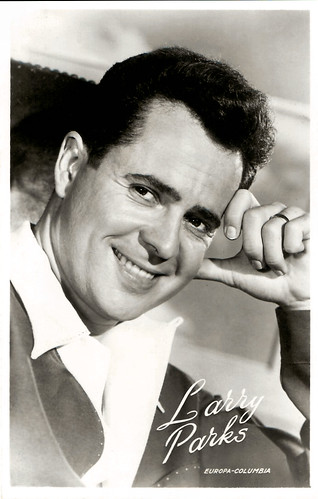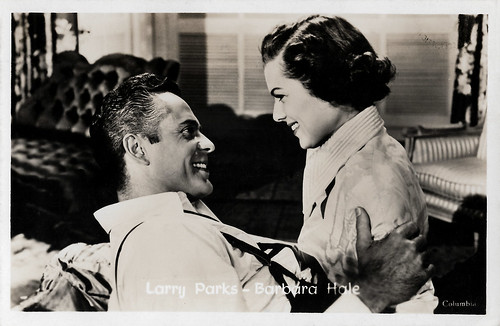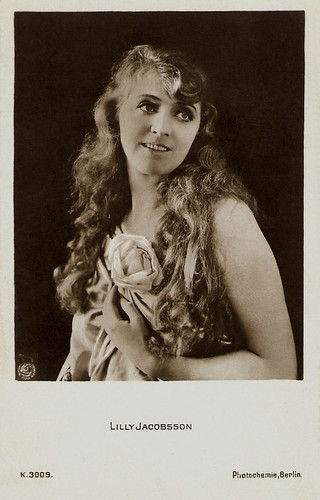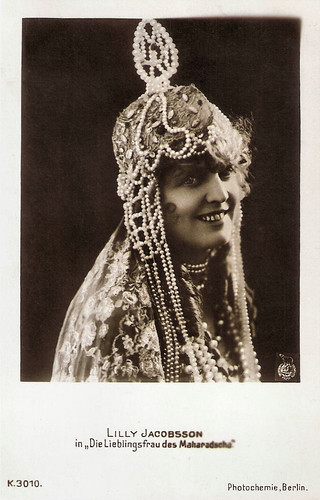Australian-born actor Errol Flynn (1909-1959) achieved fame in Hollywood with his suave, debonair, devil-may-care attitude. He was known for his romantic Swashbuckler roles in films like Captain Blood (1935) and The Adventures of Robin Hood (1938), often co-starring with Olivia de Havilland. In 1942, the tall, athletic and exceptionally handsome, Flynn became an American citizen. He developed a reputation for womanising, hard-drinking and for a time in the 1940s, narcotics abuse. He was linked romantically with Lupe Vélez, Marlene Dietrich, and Dolores del Río, among many others.

British postcard in the Picturegoer Series, no. 1301. Photo: Warner Bros.

Vintage postcard.
Errol Flynn in
Captain Blood (Michael Curtiz, 1935).

Dutch postcard by Takken / 't Sticht, no. a.x. 399. Photo: Warner Bros.
Errol Flynn in
The Charge of the Light Brigade (Michael Curtiz, 1936).
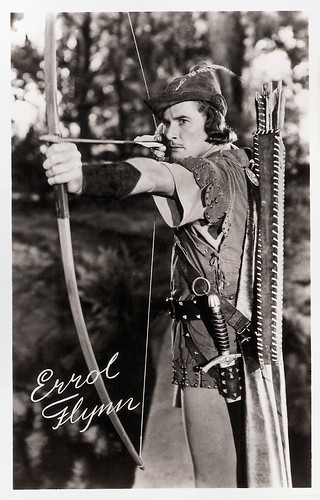
Dutch card. Photo: Warner Bros.
Errol Flynn in
The Adventures of Robin Hood (Michael Curtiz, William Keighley, 1938).

West-German postcard by Kolibri-Verlag, no. 514. Photo: Warner Bros.
Errol Flynn in
San Antonio (David Butler, Robert Florey, Raoul Walsh, 1945).

Spanish postcard by SOBE, no. 394, mailed in 1950.
Pilfering petty cash
Errol Leslie Thomson Flynn was born in a suburb of Hobart, Tasmania, in 1909. His father,
Theodore Flynn, was a lecturer and later professor of biology at the University of Tasmania. His mother was
Lily Mary Young. After early schooling in Hobart, from 1923 to 1925 Flynn was educated at the South West London College, a private boarding school in Barnes, London.
In 1926 he returned to Australia to attend Sydney Church of England Grammar School (Shore School) where he was the classmate of a future Australian prime minister,
John Gorton. His formal education ended with his expulsion from Shore for theft. After being dismissed from a job as a junior clerk with a Sydney shipping company for pilfering petty cash, he went to Papua New Guinea at the age of eighteen, seeking his fortune in tobacco planting and metals mining.
Flynn spent the next five years oscillating between the New Guinea frontier territory and Sydney. In early 1933, Flynn appeared as an amateur actor in the low-budget Australian film
In the Wake of the Bounty (Charles Chauvel, 1933), in the lead role of Fletcher Christian.
Later that year he returned to Britain to pursue a career in acting and soon secured a job with the Northampton Repertory Company at the town's Royal Theatre, where he worked and received his training as a professional actor for seven months. In 1934 Flynn was dismissed from Northampton Rep. reportedly after he threw a female stage manager down a stairwell.
He returned to Warner Brothers' Teddington Studios in Middlesex where he had worked as an extra in the film
I Adore You (George King, 1933) before going to Northampton. With his new-found acting skills, he was cast as the lead in
Murder at Monte Carlo (Ralph Ince, 1935), now considered a lost film. During its filming, he was spotted by a talent scout for Warner Bros. and Flynn emigrated to the U.S. as a contract actor.

Belgian collectors card by Chocolaterie Clovis, Pepinster. Photo: publicity still for
Captain Blood (Michael Curtiz, 1935). Collection: Amit Benyovits.

French postcard by Editions Chantal, Rueil-Malmaison, no. 8. Photo: Warner Bros. Publicity still for
Another Dawn (William Dieterle, 1937).

American postcard by K Ltd.
Joan Blondell and
Errol Flynn in
The Perfect Specimen (Michael Curtiz, 1937).

Small German collectors card in the 'Film Stars der Welt ' series by Greiling-Sammelbilder, series E, no. ?25. Photo: Warner Bros.
Errol Flynn in
Dodge City (Michael Curtiz, 1939).

French postcard by Erpé, no. 546. Photo: Warner Bros.
Striking good looks
In Hollywood, Errol Flynn was first cast in two insignificant films, but then he got his great chance. He could replace
Robert Donat in the title role of
Captain Blood (Michael Curtiz, 1935). Flynn's natural athletic talent and good looks rocketed him overnight to international stardom.
Over the next six years, he was typecast as a dashing adventurer in
The Charge of the Light Brigade (Michael Curtiz, 1936),
The Prince and the Pauper (William Keighley, 1937),
The Adventures of Robin Hood (Michael Curtiz, William Keighley, 1938; his first Technicolor film),
The Dawn Patrol (Edmund Goulding, 1938) with
David Niven,
Dodge City (Michael Curtiz, 1939),
The Private Lives of Elizabeth and Essex (Michael Curtiz, 1939) and
The Sea Hawk (Michael Curtiz, 1940).
His striking good looks and screen charisma won him millions of fans. Flynn played an integral role in the re-invention of the action-adventure genre. In collaboration with Hollywood's best fight arrangers, Flynn became noted for fast-paced sword fights. He demonstrated an acting range beyond action-adventure roles in light contemporary social comedies, such as
The Perfect Specimen (Michael Curtiz, 1937) and
Four's a Crowd (Michael Curtiz, 1938), and the melodrama
The Sisters (Anatole Litvak, 1938).
During this period Flynn published his first book, 'Beam Ends' (1937), an autobiographical account of his sailing experiences around Australia as a youth. He also travelled to Spain, in 1937, as a war correspondent during the Spanish Civil War.
Flynn co-starred with
Olivia de Havilland a total of eight times, and together they made the most successful on-screen romantic partnership in Hollywood in the late 1930s-early 1940s in eight films. Flynn's relationship with
Bette Davis, his co-star in
The Private Lives of Elizabeth and Essex (Michael Curtiz, 1939), was quarrelsome. Davis allegedly slapped him across the face far harder than necessary during one scene.

French postcard by Editions P.I., Paris, no. 213. Photo: Warner Bros.

Dutch postcard by M.B.&Z., no. 1050. Photo: Warner Bros.

German postcard by Edition Cicero, Hamburg, no. 150/10. Photo: Elmer Fryer, 1936 / The Kobal Collection.

British postcard in the Picturegoer Series, London, no. W 65. Photo: Warner Bros.

British postcard by Milton, no. 152. Photo: First National Films.

German postcard by Ross Verlag, no. A 2332/2, 1939-1940. Photo: Schostal.
Paragon of male physical prowess
In 1940, at the zenith of his career, Erroll Flynn was voted the fourth most popular star in the US. Flynn became a naturalised American citizen in 1942. As the United States had by then entered the Second World War, he attempted to enlist in the armed services but failed the physical exam due to multiple heart problems and other diseases.
This created an image problem for both Flynn, the supposed paragon of male physical prowess, and for Warner Brothers, which continued to cast him in athletic roles, including such patriotic productions as
Dive Bomber (Michael Curtiz, 1941),
Desperate Journey (Raoul Walsh, 1942) and
Objective, Burma! (Raoul Walsh, 1945).
His womanising lifestyle caught up with him in 1942 when two underage girls,
Betty Hansen and
Peggy Satterlee, accused him of statutory rape at the Bel Air home of Flynn's friend
Frederick McEvoy, and on board Flynn's yacht, respectively. The scandal received immense press attention. Many of Flynn's fans, assuming that his screen persona was a reflection of his actual personality, refused to accept that the charges were true. Flynn was acquitted, but the trial's widespread coverage and lurid overtones permanently damaged his carefully cultivated screen image as an idealised romantic leading player.
In 1946, Flynn published an adventure novel,
Showdown, and earned a reported $184,000. In 1947 he signed a 15-year contract with Warner Bros. for $225,000 per film. After the Second World War, the taste of the American film-going audience changed from European-themed material and the English history-based escapist epics in which Flynn excelled to more gritty, urban realism and Film Noir, reflecting modern American life.
Flynn tried unsuccessfully to make the transition in
Uncertain Glory (Raoul Walsh, 1944) with
Paul Lukas,
Cry Wolf (Peter Godfrey, 1947) with
Barbara Stanwyck, and then increasingly passé Westerns such as
Silver River (Raoul Walsh, 1948) and
Montana (Ray Enright, 1950). Flynn's behaviour became increasingly disruptive during filming; he was released from his contract in 1950 by
Jack L. Warner as part of a stable-clearing of 1930s glamour-generation stars. His Hollywood career over at the age of 41, Flynn entered a steep financial and physical decline.

French postcard, no. 764. Photo: Warner Bros.
Errol Flynn in
The Adventures of Robin Hood (Michael Curtiz, William Keighley, 1938).

French postcard by Éditions P.I., Paris, no. 213. Photo: Warner Bros.

British postcard by Art Photo, no. 92.

French postcard, no. 731.

French postcard by Viny, no. 49. Photo: Warner Bros.
A parody of himself
In the 1950s, Errol Flynn became a parody of himself. He lost his savings from the Hollywood years in a series of financial disasters, including
The Story of William Tell (Jack Cardiff, 1954) with
Waltraut Haas. Aimlessly he sailed around the Western Mediterranean aboard his yacht Zaca. Heavy alcohol abuse left him prematurely aged and overweight.
He staved off financial ruin with roles in forgettable productions such as
Hello God (William Marshall, 1951),
Il maestro di Don Giovanni/Crossed Swords (Milton Krims, 1954) opposite
Gina Lollobrigida and
King's Rhapsody (Herbert Wilcox, 1955) with
Anna Neagle.
He performed in such also-ran Hollywood films as
Mara Maru (Gordon Douglas, 1952) and
Istanbul (Joseph Pevney, 1957) with
Cornell Borchers, and made occasional television appearances. As early as 1952 he had been seriously ill with hepatitis resulting in liver damage. In 1956 he presented and sometimes performed in the television anthology series
The Errol Flynn Theatre which was filmed in Britain.
He enjoyed a brief revival of popularity with
The Sun Also Rises (Henry King, 1957),
The Big Boodle (Richard Wilson, 1957), filmed in Cuba;
Too Much, Too Soon (Art Napoleon, 1958), and
The Roots of Heaven (John Huston, 1958) with
Juliette Gréco. In these films, he played drunks and washed-out bums and brought a poignancy to his performances that had not been there during his glamorous heydays.
He met with
Stanley Kubrick to discuss a role in
Lolita, but nothing came of it. Flynn went to Cuba in late 1958 to film the self-produced B film
Cuban Rebel Girls (Barry Mahon, 1959), where he met
Fidel Castro and was initially an enthusiastic supporter of the Cuban Revolution. He wrote a series of newspaper and magazine articles for the New York Journal
American and other publications documenting his time in Cuba with Castro. Many of these pieces were lost until 2009 when they were rediscovered in a collection at the University of Texas at Austin's Center for American History. He narrated a short film titled
Cuban Story: The Truth About Fidel Castro Revolution (1959), his last known work as an actor.
He published his autobiography, 'My Wicked Wicked Ways'. In 1959, Errol Flynn died of a heart attack in Vancouver, Canada. He was married three times. His first wife was actress
Lily Damita (1935-1942). They had one son, actor and war correspondent
Sean Flynn (1941-1971). Sean and his colleague
Dana Stone disappeared in Cambodia in 1970, during the Vietnam War, while both were working as freelance photojournalists for
Time magazine. It is generally assumed that they were killed by Khmer Rouge guerrillas.
Errol was married a second time to
Nora Eddington from 1943 to 1949. They had two daughters,
Deirdre (1945) and
Rory (1947). His third wife was actress
Patrice Wymore from 1950 until his death. They had one daughter,
Arnella Roma (1953–1998). In 1980, author
Charles Higham published a controversial biography,
Errol Flynn: The Untold Story, in which he alleged that Flynn was a fascist sympathiser who spied for the Nazis before and during the Second World War and that he was bisexual and had multiple gay affairs. Later Flynn biographers were critical of Higham's allegations and found no evidence to corroborate them.

Italian promotional postcard for Canapa, 1950s. The card refers to hemp fibre, of which Italy used to be an active producer. Hemp was used for all kinds of textile products like towels and sheets but also furniture covers. Caption: Besides being very useful, Italian hemp embellishes the house. The Canapa cards were addressed to a female audience.

French postcard by Edition P.I., offered by Les Carbones Korès, no. 353. Photo: Warner Bros, 1953.
Errol Flynn in
Adventures of Don Juan (Vincent Sherman, 1948).

French postcard in the Entr'acte series by Éditions Asphodèle, Mâcon, no. 003/5. Collection: B. Courtel / D.R.
Errol Flynn on the set of
Montana (Ray Enright, 1949). Caption: A solution to refresh yourself without getting wet! Errol Flynn, in between takes, can't stand the heat of the Hollywood summer.

Vintage postcard. Photo: Warner Bros.
Errol Flynn on his sailing boat the "Zacca".

West German postcard by F.J. Rüdel, Filmpostkartenverlag, Hamburg-Bergedorf, no. 295. Photo: Metro-Goldwyn-Mayer.
Errol Flynn in
Kim (Victor Saville, 1950).

Belgian postcard, no. 731. Photo: Metro-Goldwyn-Mayer.
Errol Flynn and
Laurette Luez in
Kim (Victor Saville, 1950).

Vintage card. Photo: Warner Bros.
Errol Flynn in
Against All Flags (George Sherman, 1952).

German postcard by Kunst und Bild, Berlin, no. A 454. Photo: Universal International. Publicity still for
Against All Flags (George Sherman, 1952).

Dutch postcard by 't Sticht, Utrecht, no. 3059. Photo: Warner Bros. Sent by mail in the former Dutch Indies in 1949.
Sources:
Charles Culbertson (IMDb),
Wikipedia and
IMDb.
